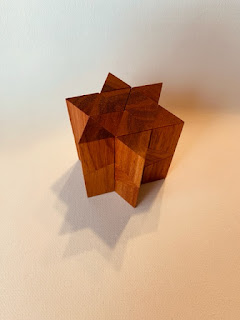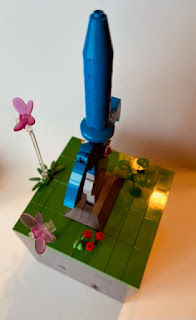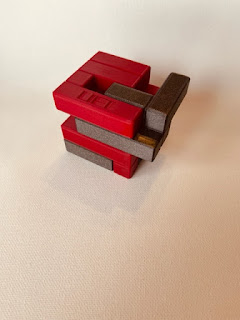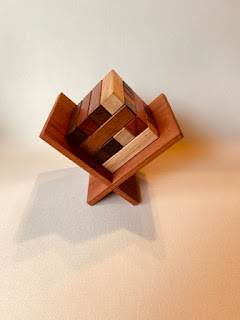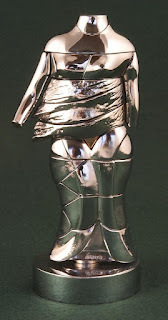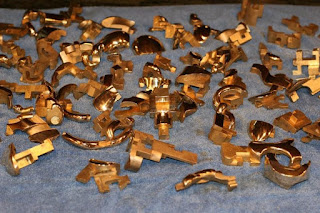This post is written by John Rausch:
My days of selling Berrocal Sculptures by John Rausch
“For several years I sold Berrocal sculptures. Most new ones came from Studio Berrocal. They fabricated six ManyMoreHorses in silver for me at a very reasonable price. Some of you have one of them. At the time, they even had some new Alexanders they didn’t tell most dealers about. I sold one, though very tempted to keep it. I sold Berrocals to puzzle collectors with very minimal markup. On eBay, some sold for crazy prices. Then came Euros. Along with that, the price of the larger series like Goliath, Richelieu, Hoplita, that were $5,400 wholesale, went up to $7,000, or more. That was the end for me.
I think it was in the late 1990s, I found that the Die Galerie in Frankfurt, Germany sold Berrocal, even the giant stuff. I called and spoke with Peter Femfert, the owner. He was the main European dealer selling retail at his gallery and wholesale to other galleries in Europe. I asked if he had any Manolete sculptures for sale. He had one. I told him I would buy up to 20 of them and explained about we puzzle collectors who want them. He told me he would contact galleries that had many of them since the 1970s and couldn’t sell them. He found 12 and I bought them for about $1,200 each figuring in the shipping cost. I sold them to collectors for $1,500, maybe less if I liked you. Two or three had the book missing. Peter had Berrocal make some copies of one that were acceptable for assembly. Those cost me less and I sold them for less. They were all gone in a few weeks. I called Peter and asked if he could find more. He could not believe it! He found 6 more for the same price. They were gone in a couple of weeks. He couldn’t find more. I know many of the IPP people who have one. Peter told me he had never had a gallery want so many Berrocal sculptures in such a short time. He told me he had a small place in Tuscany that I was welcome to stay in if I were every down that way. It’s a very old, fairly large winery, but that’s another story.
Something you may or may not know. Goliaths and Manolete were not cast by Studio Berrocal. The Goliath design was commissioned by a gallery in Düsseldorf, and cast by a foundry in Germany. The quality of the castings is very accurate, much different than most all of the brass and bronze cast by Studio Berrocal. For example, the internal parts of Richelieu are totally covered with grinder marks to make them fit. A photo shows a restored and partially assembled Richelieu. Some of the Richelieu sculptures have pieces so tight, it takes a lot of force to take them apart. Manolete was commissioned by L’Oréal in Paris, and was also cast elsewhere, but I don’t know where. Its pieces are perfect and have no grinder marks. Maybe a slight filing on a couple of pieces, usually the bottom of very tight thigh pieces. Both of these sculptures fit together perfectly, and both are highly desirable.
Then there are the Minis and micros. I think the minis and all but one of the micros are junk. They were made in large quantities (the editions were 10,000 and more), cast in zamak, known by other names, but the common name is pot metal or monkey metal. Look it up. Mostly zinc, but any other metals laying around can go into the pot, but probably don’t for good foundries. Matchbox cars and Dinky toys are made from pot metal and painted. The Minis pieces were heavily plated with chrome or nickel. The sculptures go together with a lot of designed slop so they could just be put in the box. When assembling, every few pieces there is a piece with a steel plate riveted to it that goes in with a bit of force and wedges the previous pieces tightly. Most of these you can find today has corrosion or pitting that can’t be restored. They look very dull. More about more than 2,000 of these in my next post.
There is one Micro that is very nice, MicroDavidOff. It was sold mostly in Nickel plated pot metal, stainless steel, silver or gold. I have seen brass ones. The edition was 1,000,000, but I doubt they came close to making that many. I don’t have the large Antologica Berrocal book now, but maybe someone can check. They fit together very nicely. One of the stainless ones is the only Berrocal I have now. The side of the box reads “WARNING from Berrocal’s Studio: if you do not buy it today, you will damage your pocket tomorrow.” Mine is No, 41228.
Silver ManyMoreHorses
Parts are refinished. Note the condition of the internal parts of the pieces.
Note the grinder marks on nearly every piece.
Front
Mostly, I sold preowned Berrocal I bought on eBay or from owners who contacted me after finding Berrocal sculptures on my PuzzleWorld website. Some wanted a lot for them having seen outrageous estimated values at auctions like Sotheby”s, others only wanted what they paid for them in the 1960s, or less.
There were two main dealers of Berrocal in the U.S., Katzen Gallery, owned by Arnold Katzen, in New York City, and Centicore Arts, International in Ann Arbor, Michigan. Together they produced a catalog called 𝘛𝘩𝘦 𝘗𝘶𝘻𝘻𝘭𝘦 𝘚𝘤𝘶𝘭𝘱𝘵𝘶𝘳𝘦𝘴 𝘰𝘧 𝘔𝘪𝘨𝘶𝘦𝘭 𝘉𝘦𝘳𝘳𝘰𝘤𝘢𝘭. You can buy one now, and maybe it will be for sale for years to come for only $1,260 at Alibris - alibris.com/booksearch.detail?invid=15791376680.
In 2004, Katzen was convicted of conspiring to fail to pay estimated tax. He was also convicted of laundering drug money. The gallery went bankrupt. Katzen had a huge stock of unsold Minis and a few other larger ones that had no appeal to puzzle people. One of his creditors accepted the entire Berrocal stock as partial payment towards what he was owed. He had no idea what to do with them, but had a friend, or acquaintance, that owned an antique business in a barn somewhere in Pennsylvania, New Jersey, or somewhere not far from New York City. He gave them all to her. I am pretty sure her first name was Virginia, but can’t remember her last name. Like many who searched for Berrocal back then, my web site came up first because there are quite a few Berrocal pages. She contacted me and asked what she could do with them. I told her I could sell some, but not 2,000.
Most of the Minis were Marias, Zoradas, and MicroDavidOffs in stainless steel. She was told to sell them for $200 to $250. Okay! I bought at least 20 MicroDavidOffs and half a dozen of the others. Mini Davids were slightly more. I was thinking I would make a killing on eBay! Not so fast – she listed a lot of them on eBay for less than $500. She basically killed the Berrocal Mini market on eBay for a few years. I sold most of the ones I bought to puzzle collectors.
Then came the flood! Virginia, or whatever her name is, had stored them in a shed outside the barn. It was under water. After they dried out, she asked me if I thought they could be salvaged even though the boxes and books were ruined. She sent me a few Marias and Zoradas. The plated parts were okay, but the ones that had steel plates riveted to them had rusted, and stained the pieces. I shipped them back and have no idea what she did with them.
This was pretty much the end of me buying, restoring, and selling Berrocal sculptures except for Goliaths, Manoletes, and a few Richelieus . They would sell on eBay the same day I posted them, often within minutes. I did not make a lot on them, but they sold quickly and I had fun restoring them.
Mini David
Portrait of Michelle
Mini Maria
Mini Cariatide
Mini Zorada
Mini Cristina
Several years ago, I posted on my personal timeline about restoring/refinishing Brass and Bronze Berrocal puzzle sculptures. In almost all cases, they can be put back to perfect condition, but to do that well, you will need a bench buffer. A grinder usually turns at a higher RPM. If you have a variable speed grinder you might be okay, but if you put a buffing wheel on a grinder, you will have parts thrown all over the place.
Here in the U.S., we have a chain store called Harbor Freight that sells Chinese tools. They have fairly inexpensive ones, and they have the rouge you need. Several different rouge types are sold. What you want is red. It's called “Jeweler’s Rouge”, but not but most stores. For one large sculpture like Goliath you need at least a quart of Brasso. I bought gallon cans on Amazon. The Brasso is used only for soaking the pieces to get the internal parts clean, not polishing. Scrape off any hardened Brasso that was worked inside the sculpture with a wooden stick like a tongue depressor, snapped in half comes in handy. I know where to get a lot of them. Then soak the pieces in the Brasso for about an hour. You don’t have to rub them, Just make sure the internal piece parts are submerged.
After an hour, nearly all of the internal parts will be clean. If not, leave them longer. But there will be black bits of old Brasso in the nooks and crannies. I use a small (half an inch wide) brass or stainless-steel brush to get at those, and tooth picks. The inside should be very clean, but not shiny. You can see what I mean in the photos, of the Richelieu photos in Part 2.
Then it’s time for polishing. Make sure the buffer is in a place where flying pieces won’t damage anything, and not on a concrete floor because it will damage the pieces. Why am I warning about this? Because you must not push a piece edge up into the buffer wheel or it will take it right out of your hands and slam It into the floor. Polish the pieces gently with a rounded part up and rotate them towards you. If this is not possible, tilt the piece and rotate it to avoid the edge – or hold on for dear life. Of course, you are only going to polish the outside of the pieces that show when assembled.
The rouge is applied to the buffer wheel by holding the rouge stick against the wheel for several seconds. You will see it turn red. Don't overdo it. Don’t use too much force when polishing the piece. It won’t take long for the piece to look like new. If there are scratches that are more than the typical “hair line” surface ones, you can try using a little more pressure. Bases are often corroded (that’s what it looks like to me) a little. It can be polished out. The one in the photos took a while and pressure was needed. You are removing a tiny bit of material by polishing. This might seem undesirable, but it was done when it was made, so who decides when to stop.
The buffer wheel will turn black as you polish. When you see it’s also a tiny bit shiny, it’s time to clean it. This is done by pushing something hard into the wheel. I used an old chisel with a ground down edge. Even a flat bladed screwdriver works. Hold on tight. The Wheel won’t be clean, but the soft part will be black and soft. Time to apply more rouge.
This whole polishing part does not take long. Way under an hour for the 80 pieces in a Goliath. After polishing, I wash the pieces in soap and water and let them dry before assembling. I use cheap museum gloves because I don’t want any finger oil on the pieces. After its assembled, I apply a coat of Renaissance Wax, being careful to not get globs in the space between the pieces. Yes, this wax is used on metal, it says so on the can. What it will do is slow down the tarnishing.
I have heard from many people to not polish bronze. Fooey! It was polished when it was new, and if you have a Manolete, for example, that looks like crap, polish it the same as I have described. Then don’t play with it without wearing museum gloves and it will develop a wonderful patina in a few years.
When someone asks "what did you do on New Years Day" these three post are what I did. Now for the tequila.
The end.”
Base is not looking so good
Pile of dirty, Brasso filled pieces
Close up of what the Brasso will remove
In a stainless-steel bowl and ready for the Brasso bath.
After Polishing











